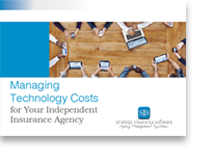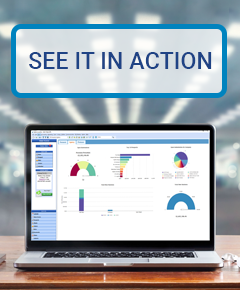Agency Operations, Community
 Community engagement is an excellent way to help your independent insurance agency stand out from the crowd. When you show you know and care about your local community, you show yourself as a trustworthy organization. Additionally, a recent Entrepreneur Magazine article shows many individuals, especially millennials, consider community engagement when looking at an organization*. So, how can your agency become more involved in your city or town?
Community engagement is an excellent way to help your independent insurance agency stand out from the crowd. When you show you know and care about your local community, you show yourself as a trustworthy organization. Additionally, a recent Entrepreneur Magazine article shows many individuals, especially millennials, consider community engagement when looking at an organization*. So, how can your agency become more involved in your city or town?
1. Sponsor an event
Local 5Ks, charity auctions, and other such fundraising events always need sponsors. Step up and offer to support. Donate money, supplies, or even your time through employee volunteers. Being a part of such fundraisers shows you care and gets your name out there on the promotional materials (t-shirts, banners, programs, etc.)
2. Get involved in schools
Schools are the center of most communities. In your agency offices, collect supplies like pencils and folders to donate, or advertise for school events like plays or concerts. These small touches show you care about your local schools and don’t take much effort on your part.
3. Start (or sponsor) a team
Get your agency involved in a local volleyball, bowling, t-ball or other league. Your team need not be restricted to your staff – extend invitations to customers and partners as well. Being involved in these leagues will give people a chance to know your agency personally. Forming a team not only engages your community, but builds community within your agency as well.
If you don’t want to get sweaty yourself, sponsor a local youth sports team. Not only will you have a grateful group of kids and parents, you often get free advertising with your name emblazoned on the jerseys.
4. Volunteer your services
One of the best ways you can engage in your community is by giving your time and talent. Offer to help local community centers and nonprofits figure out their insurance needs or provide free advice during a local street fair or community festival. Donating your services gives people a taste of your agency’s personalized service, and shows your agency has a heart for giving back.
No matter what you do, make sure people know you’re doing it. Put pictures on your website of volunteer events, and list dollar amounts of what you’re giving away. Blog about events you attend or groups you sponsor. At a minimum: post to social media. Current and potential customers need to know how you’re engaging in the community in order to see you as a local presence.
We at SIS invest in our local community here in Columbus, and in our Partner XE client community. To find out more about SIS and Partner XE community, visit our website at here!
*Source: http://www.entrepreneur.com/article/226974
Agency Operations, Community

We engage with and live in a variety of community environments throughout our work and life. Our workplace, neighborhood, running group– these are all groups of people that form communities. When it comes to your independent insurance agency, the first community you might think of is your staff. However, there are many others—from the town you live and work in to your Rotary, state or national professional insurance association, or your agency management system user group. Not to be forgotten are your customers. Of course, depending on your level of involvement you may not really consider these groups to be “communities,” just people living where they live and doing what they do.
Formal definition aside, the true benefit of community comes of what YOU make of it. You need to recognize the benefits and foster relationships within your various groups.
Why do we form these communities? What is it that draws us together? Why should your agency be concerned about community? The usual response is that communities fill a human need to be connected with one another. Although coming together in such groups does speak to this need, forming and fostering communities brings other benefits as well. As a whole, communities:
Multiply resources
Each individual in a community has certain assets. By joining with others, the number of available resources multiplies. As we know, no one person can “have it all,” but a community can come close!
Ensure longevity
Even if a community is not multi-generational, it still has the power of continuation as new members join. This creates stability for the group and opens up opportunities to create big change, knowing the ideas and plans put in motion will continue on after those who set them up leave.
Foster connections
Relationships can grow and strengthen within a community. As relationships develop, members are apt to introduce new connections. Similar to the multiplication of resources, each group member has its own connections to others outside the community. These connections can be fostered and utilized for the benefit of its members.
At SIS, we value community within our workplace, and beyond our office walls by participating in community service locally here in Columbus. We want our clients to experience that same community, which is why we invest in NASPA, the Partner XE user group. Through regional learning sessions, national conferences, and product improvement workgroups, NASPA connects Partner XE users across the country. NASPA not only helps Partner XE users connect and form relationships, but educates our users on the most effective ways to use Partner XE and its capabilities. To find out more about NASPA, including our regular regional conferences, contact us today at [email protected].
Agency Operations
 As we round out our series on email etiquette we conclude with an important, yet easy to forget, aspect of emailing: conveying tone. With face to face or phone conversations, tone can be interpreted through an individual’s voice inflection, but with email this is not possible. When writing an email, you must keep in mind your audience (co-worker, prospect, client, vendor) and be intentional in conveying your message. Here are four quick tips to help you communicate clearly, avoiding misinterpretations and negative consequences.
As we round out our series on email etiquette we conclude with an important, yet easy to forget, aspect of emailing: conveying tone. With face to face or phone conversations, tone can be interpreted through an individual’s voice inflection, but with email this is not possible. When writing an email, you must keep in mind your audience (co-worker, prospect, client, vendor) and be intentional in conveying your message. Here are four quick tips to help you communicate clearly, avoiding misinterpretations and negative consequences.
1. Don’t use sarcasm
Although it may be tempting to add in a seemingly funny, sarcastic line, remember that the nuances of your tone cannot be conveyed via email. Using sarcasm can lead to unintended consequences such as offending a colleague, the repercussions of which can be quite embarrassing. In the same vein, be careful making any type of joke via email in a professional environment. When in doubt, leave it out.
2. Avoid “flaming”
“Flaming,” a virtual term for venting/sending inflammatory messages, is not appropriate nor helpful. You may feel the need to correct someone or point out why a project went wrong, but email is not the place. To keep yourself from sending something you may regret, ask yourself if you would say what you’re writing face to face. If you wouldn’t, don’t include it. If you would, find them and have a frank discussion instead.
3. Use positive wording
Always start your emails with an appropriate, positive greeting. This puts the reader in a good mindset. Keep this tone throughout your email – be friendly, but keep to business related items. It is helpful to close by thanking the reader, and stating any next steps such as: “Thanks for your time. I look forward to meeting with you on Monday to review the attached.” By thanking the individual you build positive rapport, showing you value them and their time.
4. Check, and double check
What you say in an email cannot be taken back, so be careful what you write and send. To ensure you are not sending a message that could be interpreted negatively, read and re-read your messaged before sending. It is helpful to read your message out loud to help you judge how your wording sounds.
By paying attention to your agency communications, you’ll be on the right track to setting up positive, lasting relationships. Building such relationships is an important part of your success as an individual and as an agency. We at SIS know how important such relationships are, which is why we continually improve our Partner XE agency management system to be your most reliable tool for client relations and communication. To find out how Partner XE can help grow your client interactions, contact us today at [email protected]. We look forward to hearing from you!
Agency Operations, Technology Trends
 Technology is rapidly changing and updating, and your independent insurance agency needs to keep up. No longer does having a cell phone or laptop qualify for being up to date with tech. All aspects of your agency should be integrated with technology – from sales, to acquisitions, customer service, and marketing. The most up-to-date systems and versions are an important part of ensuring you stay relevant, especially considering the sophistication and budget of the large captive agencies.
Technology is rapidly changing and updating, and your independent insurance agency needs to keep up. No longer does having a cell phone or laptop qualify for being up to date with tech. All aspects of your agency should be integrated with technology – from sales, to acquisitions, customer service, and marketing. The most up-to-date systems and versions are an important part of ensuring you stay relevant, especially considering the sophistication and budget of the large captive agencies.
Our current eGuide addresses the ways to keep up with the latest technology while ensuring your agency is keeping costs manageable. We take a look at the essential hardware and software your agency needs, how to research the best quality, and the importance of finding the right partner. Download the eGuide now!
For more tips how to make your agency the most efficient and effective it can be, check out our other eGuides and the SIS blog, or contact us directly. We look forward to hearing from you!
Agency Operations
 Our latest blog series has focused on email etiquette, providing your agency with tips on keeping e-correspondence professional and effective. An area that many struggle with is keeping messages short and to the point. In this era of connectivity, we’re tempted to either send a long, rambling messages or multiple short, disconnected ones. Both are difficult to understand and, frankly, annoying for the recipient. The goal for your messages is to be clear and quick to the point. Here are a few ways to ensure your emails are understood, and appreciated.
Our latest blog series has focused on email etiquette, providing your agency with tips on keeping e-correspondence professional and effective. An area that many struggle with is keeping messages short and to the point. In this era of connectivity, we’re tempted to either send a long, rambling messages or multiple short, disconnected ones. Both are difficult to understand and, frankly, annoying for the recipient. The goal for your messages is to be clear and quick to the point. Here are a few ways to ensure your emails are understood, and appreciated.
- Know what you want to say. Decide on the information you want to convey before sitting down to write. Stick to one or two main points to keep from overwhelming the recipient with information.
- Put your point in the subject line. By letting people know what the email is about, they’ll be able to keep it for future reference and immediately know its content.
- Stay short. Ideally, your recipient shouldn’t have to scroll down. If you find your message is getting too long, it’s likely you need a phone call or in-person meeting. Say so at the end of your message, offering times you can connect.
- Put it in an attachment. If you have sections of documents you need to reference, attach them rather than posting in the body of an email. When sending attachments, be clear about why they are attached and in what program the file is saved.
- Use lists. Bullet points and numbering help you be succinct and clear. Also, by breaking up text, your message is less intimidating to read.
As always, reread your messages before hitting send. Chances are there is something you missed, or something you can cut out. Focus on what needs to be said. If you’re unsure about clarity, have a colleague give it a once over before you hit the send button.
Emails are the best way to relay and record information, and are especially helpful when reviewing a client’s history. Keeping this in mind, we have equipped our Partner XE with Outlook integration to ensure all e-correspondence is linked right to a client or prospect’s profile. To find out more about Partner XE’s other capabilities, visit our website or contact us at [email protected].





 Our latest
Our latest 